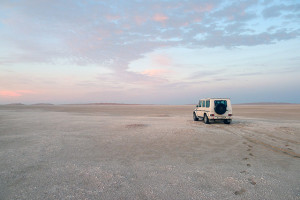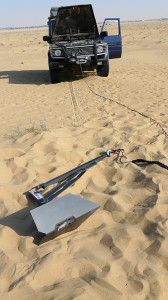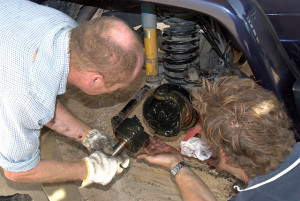Words By: Mike Nott
Photos By: Colin Campbell, Shaun Ellis, Gordon Smith and Mike Nott
It is a truth, universally acknowledged, that the risks of driving alone are inherently higher than driving in a group, but that doesn’t mean we should dismiss the idea out of hand. Solo off-road driving should not be considered the first resort of the idiotic and the last resort of the wise. There are some excellent examples of solo off-road explorations, Tom Sheppard is probably one of the leading ones, and there are many others. What I hope to dispel in this article are the fears and consequent aversion that some of you may have to solo off-road excursions in this region. The article is aimed at those that may be considering a solo, long-haul, overland trip rather than those that want to do a solo blast-in-the-local-dunes. However, those “blasts” should be considered essential practice.
The easiest way to deal with this topic is to consider what can go wrong and suggest measures that you should have in place to deal with things that do go wrong. If I were at home, I would look for Georgia auto repair locations to fix what went wrong, but this is different. First, let me state that I’m primarily going to deal with those things that are specifically necessary for solo trips. When we go off-roading in a group there is much that we should already know and carry that would be necessary whether we were going solo or in a group; such things as basic recovery equipment and how to use it, essential spares and how to fit them, communications, food and water. So, for solo trips, in addition to what we already have “normally,” we need to consider the following:
Staying out of trouble
The best approach to a successful, solo off-road trip is to avoid those things that we know can cause trouble. What does this mean? In my view, it means not over taxing our vehicle’s capabilities and our driving skills. So much of making a success of the trip is the result of good route planning. Use all the resources at your disposal. The most obvious is extensive use of Google Earth®. This remarkable resource allows us to plan in detail our intended route and we can avoid the worst areas by careful analysis of the imagery. Talk to others that have travelled through the areas you intend to go to and take advantage of any tracks or local knowledge that they may have. Dune driving is the most obvious problem area. Solo driving in the dunes is exhilarating but the constant fear of a “stuck” should concentrate your mind. Where possible, avoid technically complex dune areas and look for the easiest way through, even if it extends your journey. There is always an easier, but perhaps, longer, way round.
When conditions deteriorate and the driving becomes technically more demanding, there can be a tendency to plough on regardless and a form of panic can take over. We inevitably then make mistakes in haste that we wouldn’t when we are in the more calming presence of a group. There is a requirement to have a certain mental strength that doesn’t allow you to succumb to this “panic.” This mental strength comes from extensive driving experience in the types of terrains you’ll encounter, a thorough knowledge and appreciation of your driving ability and the capabilities of your car, and the presence of mind to be able to deal with the worst eventualities alone without becoming a quivering wreck.(Check this Trade-in Available option from car dealers to pay your car loan). But suppose the unfortunate happens, smash repairs perth take care of all the maintenance your car needs and provide the best solutions.
What you should consider before going solo for the first on a long-haul trip is to go and practice in less remote and more benign areas. Even areas that you have frequently driven in as a member of a group become very different when you’re alone and, for example, there’s no one to help pull you off a crest when you’re stuck. Your whole approach to risk taking becomes very different indeed; more cautious, more inclined to take the less technically demanding line. First get used to that feeling of being alone in areas with which you are familiar and areas from where you can reasonably walk out to the nearest road or large track if you become irretrievably stuck or broken-down. Once you’ve had plenty of practice doing that, then the mental pressure of going alone in areas where you’ve never been will be lessened.
The time of year is also a key factor in your planning. You should stick to the cooler times of the year. There are regular and tragic tales of intentional or reckless soloists who have gone into the dunes in the summer and have died. Give yourself the best possible chance of making it out by avoiding the lunacy of remote, solo dune trips in the summer.
Recovery equipment
There is a glut of equipment on the market that we can justify to ourselves that we “must” carry when off-roading. The only things I would advocate (as additions to the “normal” levels of equipment that we carry) when doing any solo, long-haul off-road trip in dunes, gravel plains, beaches and wadis, is that you should carry a self-recovery device and winch. The best self-recovery device is the US made Pull-Pal®. Of all the other known ones on the market, this is the only one that works well in soft, dry sand. It can be used in sand, gravel, mud and dirt; those terrains in which you are most likely to get stuck. It allows you to pull yourself out of the worst of bogging-ins.
These two items are expensive but they are worth the cost when they are your only solution to becoming un-stuck. If you can’t stretch to a vehicle fitted winch, there are a couple of alternatives. A hand winch (Tirfor) or a any of the best jack stands you got can be used as a hand winch but the physical effort required when using a hand winch can not be overstated. But, if it’s all you have, then there’s no alternative. Except for when a winch is the only solution, there are other types of equipment that can be used in many self-recovery situations, such as waffle boards, sand shoes and Maxtrax®, and I would advocate carrying a selection of these as well.
Vehicle knowledge and equipment
If you have to send your car to the garage to have it serviced then it is likely you do not have sufficient technical knowledge and ability to fix it should it break down in the ulu. You must know your car’s foibles, what are the common faults and equipment that fail and which could leave you stranded. You must, therefore, carry the necessary spares to replace them. This may be a particular electrical relay, or a v-belt pulley, or an electrical sensor. You must be able to work out the cause of a breakdown and have the technical knowledge as well as the spare parts and/or technical ability to be able to replace or repair it. You need practical experience of repairing a car in the wilds and have sufficient mechanical nous to be able to think your way round a seemingly intractable problem and come up with a solution that will get you moving again, even if it’s only to the nearest road.
Modern cars comprise a maze of electrical complexity which, to the layman, present a daunting prospect if you have an electrical problem. I would suggest that solo off-roaders carry an electrical diagnostic device that can tell you where the problem lies. This will help you work out a solution and, it is hoped, you’ll be carrying a spare and have the knowledge to replace it or even circumvent it. It is also advisable to carry the phone number of a friendly vehicle technician or knowledgeable friend who you could call and discuss the problem and possible solutions with.
Before you head down for the drive make sure that your car is in excellent condition or opt for renting a car as this can help you in the long run and If you want to sell off your existing vehicle as you are planning to buy a new one, then check out this website.
Worst case scenarios
Should you breakdown and can’t repair your car, or you damage it beyond repair, or are irretrievably stuck and are consequently stranded, you are going to be faced with some stark choices. Communications and navigation devices are going to be extremely important in this situation. In addition to your mobile phone you should carry a satellite phone and know the emergency number for the country in which you’re in. You should also be able to call the person with whom you’ve left your itinerary and who you have forewarned that you may call if it all goes belly-up.
An alternative to a satellite phone is to carry a personal locator beacon (PLB). PLBs are more usually found amongst the personal survival equipment of pilots and mariners. However they are more frequently being used by people on land. If you chose to buy a PLB you should ensure that it is a 406MHz transmitter and that it has an inbuilt GPS. Each PLB has a unique identifier code, which can be registered with an official government rescue agency and allows them to identify the holder/user. To register your PLB you may wish to call the UAE SAR organisation (800 UAESAR) and they will log you and your PLB’s details. The UAE has a receiving station for PLB transmissions and an established search and rescue service.
When activated by the user, the PLB will transmit a distress signal with the personal identifier code and the GPS location, which will be picked up by the local user terminal. In effect, the PLB will alert the search and rescue services and be able to tell them exactly where you are located and who you are (if registered). If you do have a PLB you should know that they are not to be used lightly. They should only be used in life threatening situations where your only possible means of survival is to be rescued by government funded rescue agencies. If you can dial 999, it is suggested that you do not use your PLB.
A GPS (I would advocate two, both loaded with the same data) is essential because you must be able to report your location to the emergency services or a rescuing friend. In addition to GPS/s you should carry a magnetic compass and mapping of the area you’re driving in. Good quality land mapping is frustratingly difficult to procure in this region. However, aeronautical charts can be bought freely and are available down to scales of 1:250,000. They are sufficiently detailed to show most of the larger land features including roads, tracks, dune, sabkhah, mountains, water features and habitation. They can be used successfully in the more remote parts of this region. In addition, particularly for the UAE, 1:120,000 satellite photography mapping is available for off-road use. They do not show the detailed land features that would be the norm for a “government quality” map of that scale, but they can be used very effectively for navigation.
You should also consider carrying a 3L hydration pack, such as a CamelBak®, and at least a 20L rucksack so that if you reckon you can comfortably walk out to the nearest road or habitation, you’ll be able to carry sufficient food and water to last the distance. This is a calculated risk and should not be guesswork. You must know where you are and where you intend to go. If you have planned your route well, you will have this knowledge immediately to hand but, if you have communications and have spoken with the emergency services, it very likely that they will tell you to stay with the vehicle and await rescue. To this end, you should carry several days of food and water.
The final thing to consider is medical emergencies. Medical self-aid is not something that you see being offered by the normal providers of first aid courses; it’s little bit more esoteric. In the absence of that type of training being available, attendance on a routine first aid course would be of some benefit. There are a number of self-help medical books around which would be useful to take along with you. Knowing how to self-treat the usual off-road associated injuries and having the appropriate equipment in your first aid kit is key. Such things as heat burns, electrical burns, dislocated joints, broken and sprained limbs, cuts, grazes and reptile and insect bites. Also, you must know how to recognise the symptoms of heat illnesses in yourself and you should also know the correct treatment for heat illnesses and what the preventative measures are. Heat illnesses occur in several ways, such as heat exhaustion, heat stroke as well as sunburn. All are caused by too much exposure to the sun, a lack of water and too little bodily salt. Other cases of injuries caused by other cars and drivers require professional assistance from injury attorneys for cases of rear ending.
End piece
Solo, long-haul off-road trips are hugely enjoyable and provide you with invaluable experience and knowledge about yourself and what you can cope with. They are very developmental, even character building, but be under no allusion as to the amount of preparation required to ensure success and also to ensure that you are not left stranded, without food and water in the heart of some remote expanse of desert and incommunicado.




